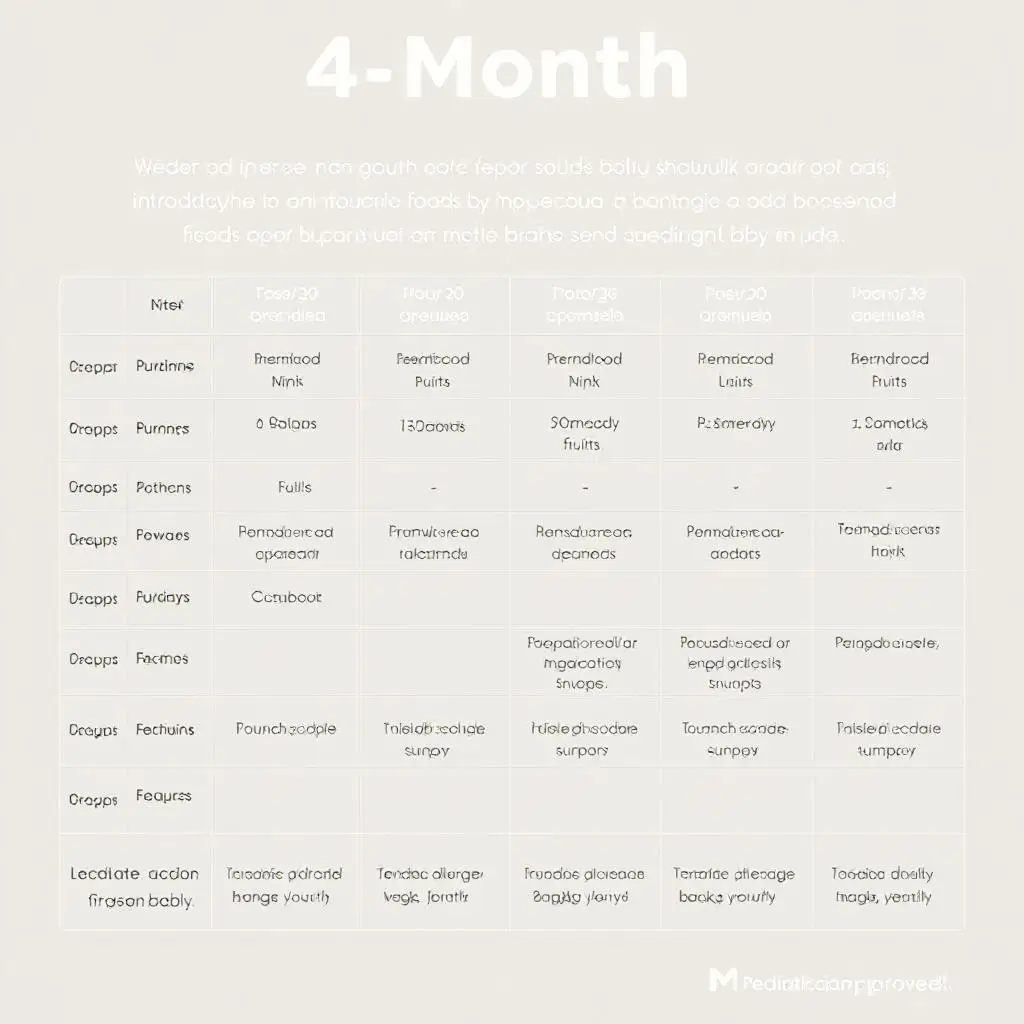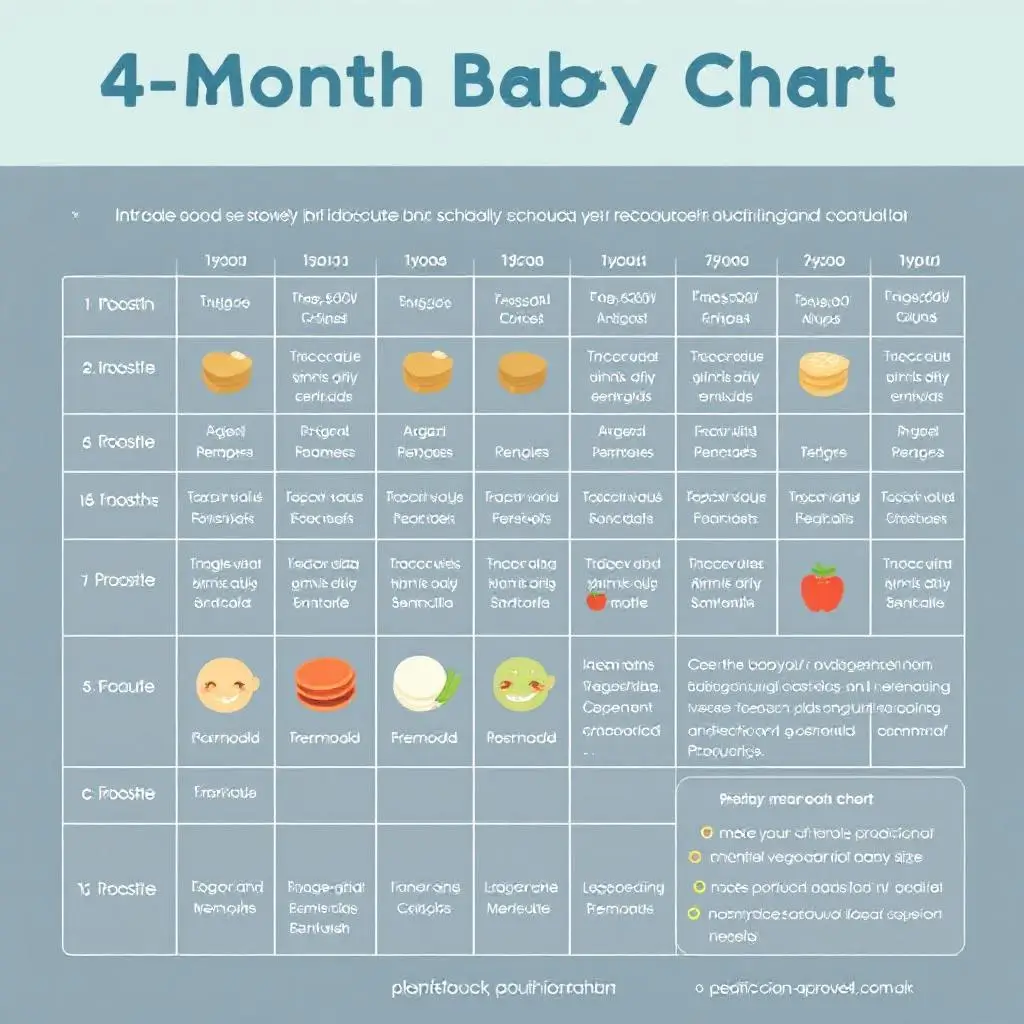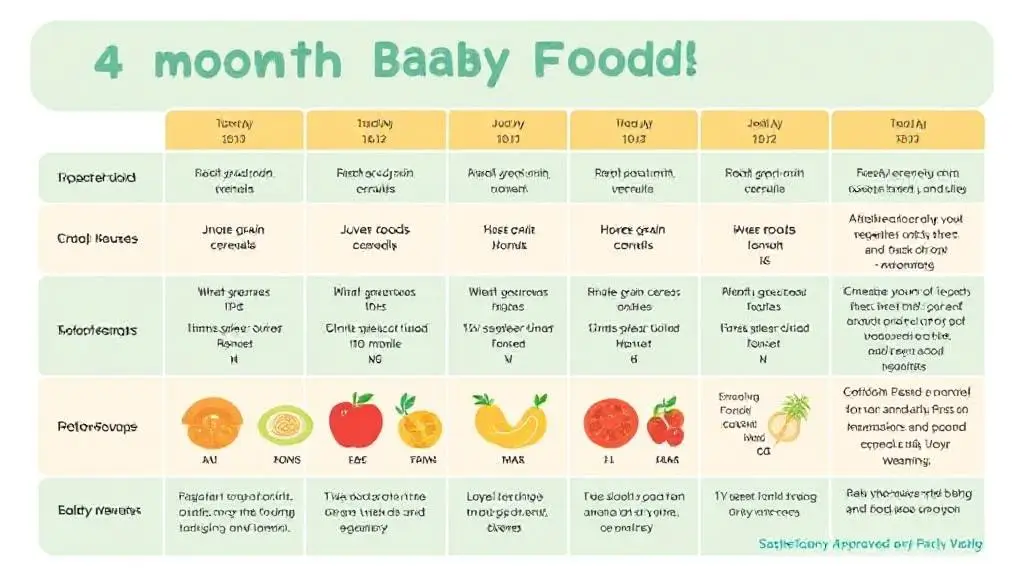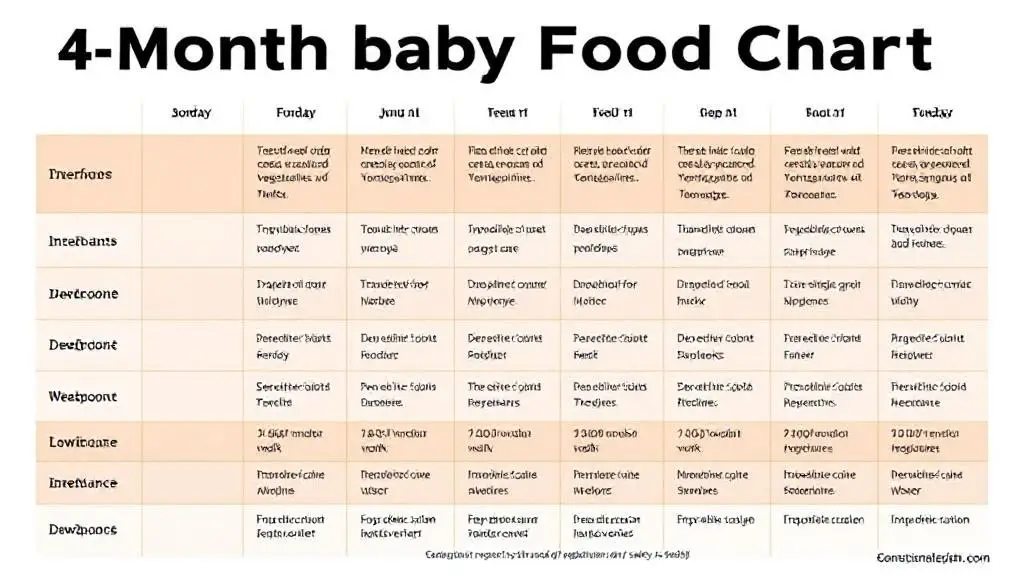4 Months Baby Food Chart
Table of Contents
4 Months Baby Food Chart : Introducing solid foods to your baby is an exciting milestone. At four months old, your baby is still primarily dependent on breast milk or formula, but you can begin introducing pureed foods. This Baby Food Chart will help you choose the best first foods, meal schedules, and portion sizes for your little one.
Why Introduce Solids at 4 Months?
Although the World Health Organization (WHO) recommends exclusive breastfeeding until six months, some babies show readiness for solids at four months. Here are signs that your baby may be ready:
- Good head and neck control
- Interest in food when others eat
- Ability to sit with support
- Diminished tongue-thrust reflex
If your baby is showing these signs, you can introduce simple, single-ingredient purees while continuing with breast milk or formula.
4 Months Baby Food Chart (Week-by-Week)
Below is a structured food chart to introduce solids gradually.
Weekly Food Introduction Plan
| Week | Food Type | Examples |
|---|---|---|
| Week 1 | Single-ingredient purees | Rice cereal, banana puree, apple puree |
| Week 2 | More pureed fruits & veggies | Sweet potato, carrot, pear |
| Week 3 | Thicker purees | Mashed avocado, pea puree |
| Week 4 | Soft cereals & mixed foods | Oatmeal, mashed banana with breast milk |
Ensure you introduce one food at a time and wait three days before introducing another. This helps detect allergies or sensitivities.

Best First Foods for a 4-Month-Old Baby
1. Single-Ingredient Purees
Start with easy-to-digest foods like:
- Rice cereal (iron-fortified)
- Banana puree
- Apple puree
These foods are gentle on the stomach and provide essential nutrients.
2. Vegetables
Vegetables introduce vitamins and minerals to your baby’s diet. Popular first veggies include:
- Carrot puree
- Sweet potato puree
- Butternut squash puree
3. Fruits
Fruits add natural sweetness and important fiber. Some good options are:
- Pear puree
- Avocado mash
- Pea puree

4. Iron-Rich Foods
At 4 months, some babies may begin trying solids, but only under the guidance of a pediatrician. Breast milk or formula should still be the primary source of nutrition. If your baby is ready for solids, iron-rich foods can be introduced slowly to support healthy development, especially as iron stores begin to decrease around this age.
Here are a few iron-rich options suitable for early introduction:
Iron-Fortified Baby Oatmeal
- Why it’s good: Gentle on the stomach, easy to digest, and often fortified with iron.
- How to serve: Mix with breast milk or formula to a thin, runny consistency. Start with 1–2 teaspoons once a day.
- Texture: Very smooth, no lumps.
Lentil Purée (Very Small Amounts)
- Why it’s good: Lentils provide plant-based iron and protein.
- How to serve: Cook red or yellow lentils until very soft, blend into a silky purée. Introduce a tiny portion (1 teaspoon) and monitor for any signs of gas or discomfort.
- Note: Lentils are higher in fiber, so introduce slowly and watch baby’s tummy.
Mashed Green Peas
- Why it’s good: Peas offer a mild dose of iron along with fiber and vitamin C.
- How to serve: Steam and blend into a smooth, runny mash. Strain to remove skins if needed.
- Tip: Peas have a naturally sweet taste that babies often enjoy.
Feeding Schedule for a 4 Months Baby Food Chart
At this stage, breast milk or formula should still be the primary source of nutrition. Below is a sample daily schedule:
Sample Daily Feeding Schedule
| Time | Food | Amount |
|---|---|---|
| 7:00 AM | Breast milk/formula | 5-7 oz |
| 10:00 AM | Rice cereal | 1-2 tbsp |
| 1:00 PM | Breast milk/formula | 5-7 oz |
| 4:00 PM | Pureed fruit/veggie | 2-3 tbsp |
| 7:00 PM | Breast milk/formula | 5-7 oz |
Tip: Introduce new foods in the morning to monitor any allergic reactions.

Tips for Introducing Solids
1. Start Slow
Give a small amount (1-2 tablespoons) once a day and gradually increase.
2. Watch for Allergies
Common allergens include dairy, eggs, and nuts. Introduce them carefully and watch for reactions.
3. Keep it Smooth
Ensure food is well-pureed to avoid choking hazards.
4. Offer One New Food at a Time
Wait three days before adding another new food to track potential allergies.
Foods to Avoid at 4 Months
Some foods are not safe for a baby at this age. Avoid:
- Honey (risk of botulism)
- Whole nuts (choking hazard)
- Cow’s milk (hard to digest)
- Salt and sugar (harmful for kidneys)
4 Months Baby Food Chart: Transitioning to More Solid Foods
By five to six months, your baby will be ready for slightly thicker textures and small portions of mashed foods. You can follow a gradual approach and include a balanced meal plan, similar to the 1400 Calorie Meal Plan designed for adults but adapted for infants.
Conclusion
Starting solids at four months can be a fun and rewarding experience for both you and your baby. This 4 Months Baby Food Chart provides a structured way to introduce nutritious foods while ensuring your baby’s health and development.
Always consult your pediatrician before starting solids, and enjoy this new phase of your baby’s growth!

